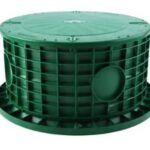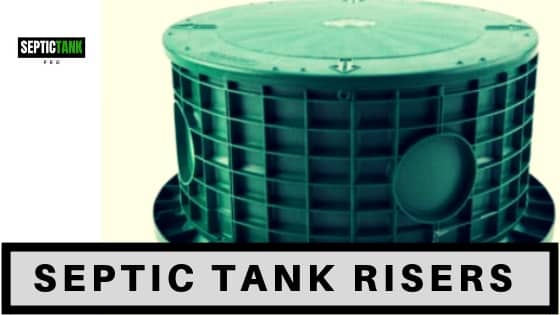What Is A Septic Riser & How Are They Installed?
When you own a new home with a septic tank there are many terms that you may not have otherwise heard of or understood prior to moving in, one of those terms for me was Septic Tank Riser.

What is a Septic Tank Riser? A Septic Tank Riser is a plastic or concrete piece of pipe that is installed from the top of the Septic Tank Pump-Out or Access Port to the surface. Older septic tanks were often installed without a riser meaning their access ports were underground and required digging of the topsoil for access.
Why Do You Need a Septic Tank Riser?
The next question you might be asking yourself is, why do you need a septic tank riser? To better understand this, let’s start by laying out why you would want to actually access your septic tank access port.
Your Septic Tank Access port or pump-out port needs to be accessed anytime your tank needs to be emptied. Depending on the size of your tank, the number of people in the house, and the demand put onto the system, you will need to pump your tank about every 3 years.
So what that means is, if you have a septic tank without a riser, every three years you will need to:
- Find your septic tank
- Locate the area above the access ports ( You better hope you have this clearly marked)
- Literally, dig down until you are able to get to the tank.
The depth of your septic tank will vary depending on the depth of your plumbing and the layout of your property, but it isn’t uncommon for your septic tank access ports to be about 4 Feet below the service.
So if you have a tank that doesn’t have installed risers, then you will need to do some digging each and every time you need to access your septic tank.
What are the Pros and Cons of Installing a Septic Tank Riser?
Pros of Septic Tank Risers
- The obvious Pro is that you will make accessing your septic tank pumping port far easier.
- That will save you a ton of time and work when you need to get your tank emptied.
- Also if you are unable to do the digging yourself, you will usually get an increased price in your septic tank service bill due to the time and work your pumping company must spend when they are pumping your septic tank.
- If you decide to sell, having a septic tank riser will make it easier for buyers unfamiliar with septic systems to understand the system.
Cons of Septic Tank Risers
- The major con to the having septic tank risers installed on your septic tank is that you will now have the lids exposed on the surface of your lawn. Which can be pretty ugly.
- If your tank doesn’t currently have a septic tank riser, you will need to spend some money to install one.
Can You Install a Septic Tank Riser on an Older Septic System?
If you are having a new septic system installed, more than likely it will include septic tank risers. However, if you have an older septic system there is a good chance that your current septic system doesn’t have septic tank risers installed.
So your question may be, can you install septic tank risers on an older septic tank? The answer is yes, you can install a septic tank riser on an older septic tank.
How to Install a Septic Tank Riser?
There are two ways to install a septic tank riser on your older septic system.
- Call a Septic Tank Professional: This is obvious but if you aren’t handy, like me. Then what you want to do is contact a local septic tank expert and let them know that you have an older septic tank and would like septic tank risers installed. Click here If you would like help finding a local septic tank service.
- Do-it-yourself installation of your septic tank riser: You can definitely install a septic tank riser if you choose to do it yourself.
DIY- How to Install a Septic Tank Riser Yourself?
So if you want to go ahead and install your septic tank riser yourself, here are the steps you will need.
- Septic Tank Riser
- Transition Ring
- Caulk Gun and Henry’s Roofing Tar
- Septic Tank Riser Lid
MAKE SURE YOU CHECK THE SIZE ON THE SEPTIC TANK RISER, ADAPTIVE RING, AND and LID TO MAKE SURE YOU GET THE RIGHT SIZES OF EACH.
Here are the steps you need to take to install your own septic tank riser on a concrete septic tank.
- Locate your septic tank
- Specifically, locate the grown above the access ports.
- Dig down to the septic tank until you get to the top.
- Remove the lid on the concrete tank
- Measure the opening from on the diagonal, from corner to corner. This will give you the size of the riser that you need. Make sure you measure on an angle from corner to corner or you will get too small of a diameter.
- Connect the Riser to the transition ring, add the roofing tar where it meets.
- Put the Roofing tar on the bottom of the transition ring
- Then install the septic tank riser above the tank access hole.
Here is a quick video that shows you exactly this process for installing your septic tank risers.
Here is a different way to install your septic tank riser using anchors.
What Brand of Septic Tank Riser is Best?
There are a couple of good brands when it comes to purchasing a quality septic tank riser. But the one that really stands out in terms of consistent customer reviews is Tuf-Tite Septic Tank Risers.
Luckily you can find the Tuf-Tite Septic Tank Risers at local septic tank wholesalers or even more convenient you can order them directly on Amazon. Check out the latest pricing on Amazon here. (Full disclosure this is an affiliate link, so if you purchase through it, Amazon will pay me a small commission. Thanks in advance if you decide to do that. )
Related Question
What Are the other brands of Septic Tank Risers?
Another brand of septic tank risers, lids, and adaptive rings that many people use and you could shop and compare to the Tuf-Tite septic tank risers is Polylok septic tank risers and lids.
Do I need to install a septic tank riser on my septic tank?
No, you do not have to install a septic tank riser on your older septic tank. Not having a riser will make no difference on the operation or life of your septic tank.
The only effect it will have is on the work it takes to get to your septic tank access ports when you are having it pumped.
Now if your tank is hard to get to and that causes you to put off emptying and getting it pumped as recommended, then that could have a detrimental effect on your septic tank.
So the short answer is, as long as you are willing to dig and reach your septic tank pumping port then you absolutely don’t need to install a septic tank riser.
Can you hide your septic tank lids after installing a Septic tank Riser?
So the point of having a septic tank riser installed is to make it much easier to actually access your septic tank, so you should be careful when trying to hide it.
Don’t hide it by planting bushes or with any permanent structure that would keep you from being able to access your septic tank pumping access port.
But with that being said, I recognize the lids in the middle of your yard might be a bit unsightly. So what you can do is use camouflage type of lid coverings that are designed to look like rocks or natural elements on your lawn.
These are great options as they are easily moved when you need to get to your tank but still look better than ugly lids and grates.
If you want to check out some cool covers that look like rocks, take a look here.
Get a local septic tank professional here.
If you need to get your septic system serviced find a local professional in our state by state directory. Simply click your state below.
[us_map]











